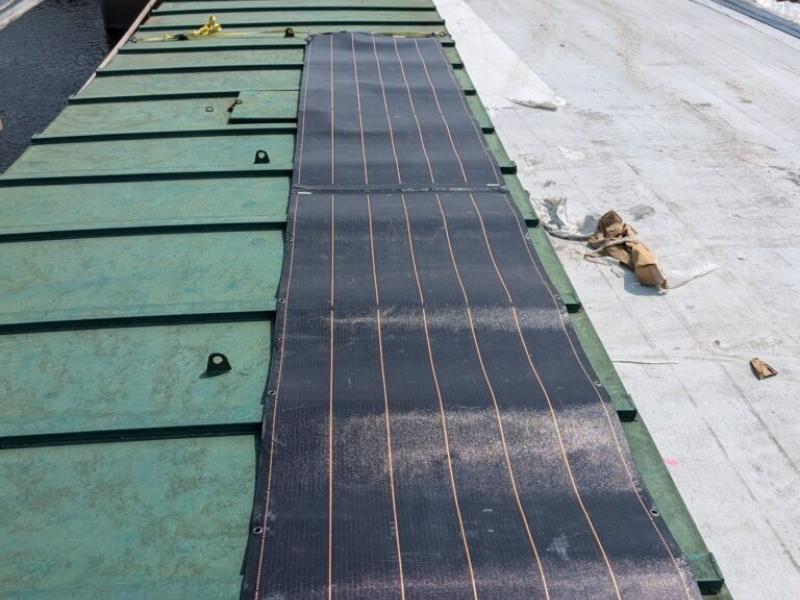
The Vancouver International Airport has released a plan to become the world’s first net-zero carbon airport by 2030. (Google Maps)
The Vancouver International Airport (YVR) has released a six-point plan to become the world’s first net-zero carbon airport by the year 2030. That’s a significantly faster timeline than its original plan to achieve net-zero in its operations by 2050.
“In looking at (the pathways) we were able to figure that it was doable,” said Marion Town, the director of climate and environment with the Vancouver Airport Authority. “It was going to be some significant investments, but we could actually achieve significant reductions by 2030. And that was important for us, for the region, for that industry and the planet to do that as quickly as we could.”
To accomplish its goal, the airport authority sees six pathways: renewable fuels, electrification of its fleet of vehicles or using renewable fuels, green electrification, on-site renewable energy supply, conservation and retrofits and closing the gap in carbon removals.
The plan does not account for emissions by aircraft, though the authority does want to minimize those emissions while the planes are on the ground.
Measures to reach net-zero underway
The airport authority reported its greenhouse gas emissions totalled 11,839 tonnes during 2020, a year when usage of the facilities was significantly reduced due to the COVID-19 pandemic. This was comprised of about 60 per cent natural gas usage, 30 per cent purchased electricity, eight per cent from its vehicle fleet and about two per cent from a variety of other smaller sources.
The plan is ambitious for Canada’s second-largest airport, which covers 4,000 acres of land, boasts a terminal that is B.C.’s largest single building and has 569 employees. Even considering the pandemic, the airport saw more than 7.3 million passengers go through its gates in 2020, down 72 per cent from 2019.
Getting to net-zero will also require assistance from a variety of partners, but Town said some of the required measures are already under way.
One example is the vehicle fleet; about 22 per cent of its vehicles are now powered by electricity and many more will be transitioned to electric. The airport operates 123 light-duty vehicles and 188 other motorized pieces of equipment including buses, snow operations and fire trucks.
Some of these vehicles are highly specialized, and there are currently no electrified options. Fire trucks are one example, so the authority plans to move to renewable diesel for these vehicles, hopefully by 2023.
Digital Twin software models energy savings
By the end of 2020, the authority reported making headway toward its sustainability goals – though some of the reductions were also related to lower traffic due to the pandemic. Overall, the airport reported a five per cent decrease of CO2 emissions, a 47 per cent decrease in its water usage and a 65 per cent decrease in total waste.
Town also credits the airport’s Digital Twin software system with moving the plan forward. The Digital Twin is a virtual recreation of the interior and exterior of the airport buildings and properties, including the airfields.
It allows the airport to run simulations under a wide range of conditions to determine energy savings and many other variables.
“What that means is you can actually say, inside the building, we can have all of the HVAC systems plotted out. And then we can layer in passenger traffic,” Town explained. “We can play a little bit to see … how much energy we will save when we shut down these whole gate areas, when traffic has actually ended at the end of the day.”
The Digital Twin can also be used to pinpoint efficiencies for aircraft movements to help airlines significantly reduce their own emissions, which in turn would impact the movements of passengers on and off the planes and inside the terminal. All of this can be factored in by the software.
Solar power, B.C. Hydro help YVR reach net-zero
Other tangible movements toward net-zero include increasing investments in solar power and ongoing conversations with B.C. Hydro to move to an entirely green hydro system.
The airport is steadily tightening its mandates for ground handlers on the airfield to utilize electrified equipment and providing EV charging capability for that equipment. The airport has two solar thermal systems designed to pre-heat the hot water in use in the terminal building, and its airside operations building also uses solar thermal, solar photovoltaic and wind power.
Carbon removal projects will include restoration of wetlands and trees, agricultural soil carbon practices, direct air capture and carbon sequestration.
Town said in addition to B.C. Hydro, the airport is working closely with Air Canada on its own decarbonization efforts. Town also highlighted the 30-year sustainability agreement with the Musqueam Indian Band, which has a seat on the airport’s environmental advisory committee.
“They have a community just across the river from us, and we are on their traditional ancestral and unceded lands,” Town said. “So I would say the roadmap is going to be a journey that we’re going to be on together.”
Town hopes the Vancouver roadmap becomes more than just a guideline for this airport; she hopes it will engage other suppliers and partners, and also benefit other organizations in the years to come.
“We want it to be a learning tool for others, and then we hope that they will actually invite others into helping us solve those remaining bits,” said Town. “Pieces of equipment that currently don’t have electric versions, or other energy conservation opportunities, or energy storage.
“So, to me, those are the exciting opportunities that lie ahead.”









